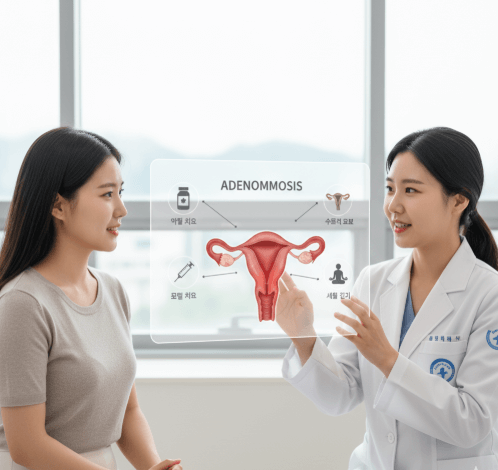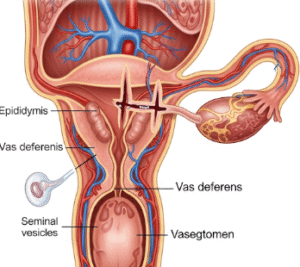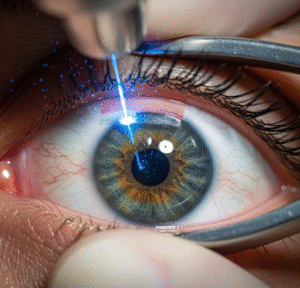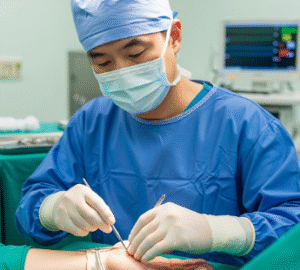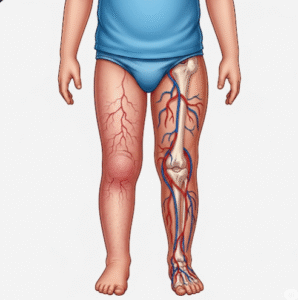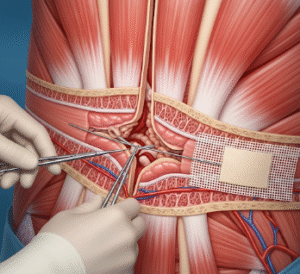What it is
Adenomyosis is a condition where the endometrial tissue (lining of the uterus) grows into the muscular wall of the uterus. This abnormal growth leads to an enlarged, tender uterus and causes painful, heavy periods.
✔️ Symptoms: Severe menstrual cramps, heavy bleeding (menorrhagia), pelvic pain, enlarged uterus, pain during intercourse, and sometimes infertility.
✔️ Causes: Exact cause unknown, but risk factors include age (30–50 years), prior uterine surgery, and hormonal imbalance.
✔️ Diagnosis: Usually done with pelvic ultrasound or MRI, and sometimes confirmed after hysterectomy.
➡️ In Korea, adenomyosis is managed with modern medical therapies, minimally invasive procedures, and fertility-preserving approaches.
Why it’s done
Treatment of adenomyosis is important because it:
🔹 Relieves chronic pelvic pain and menstrual discomfort.
🔹 Prevents anemia caused by heavy bleeding.
🔹 Improves fertility outcomes in women trying to conceive.
🔹 Enhances quality of life, reducing fatigue and discomfort.
🔹 Prevents progression to more severe disease or complications.
💡 Highlight: Adenomyosis is not just “bad periods”—it can seriously impact daily life and reproductive health if untreated.
Alternatives
Women in Korea may also consider different approaches besides medical or surgical treatments:
➡️ Lifestyle modifications – healthy diet, stress reduction, regular exercise.
➡️ Nutritional supplements – iron for anemia, vitamin D, and omega-3s for inflammation.
➡️ Traditional Korean medicine – acupuncture and herbal treatments for pain relief and cycle regulation.
➡️ Observation only – in mild cases with tolerable symptoms.
⚠️ Note: Alternatives may help relieve pain, but moderate to severe adenomyosis usually requires medical or surgical intervention.
Preparation
Before adenomyosis treatment in Korea, preparation usually includes:
✔️ Comprehensive consultation – discussion of symptoms, fertility goals, and medical history.
✔️ Diagnostic imaging – pelvic ultrasound or MRI to confirm adenomyosis and rule out fibroids or endometriosis.
✔️ Blood tests – anemia screening, hormone levels, thyroid function.
✔️ Fertility evaluation – if the patient wishes to conceive in the future.
✔️ Treatment discussion – whether to preserve the uterus or consider hysterectomy.
💡 Tip: Korean gynecologists often use MRI imaging for detailed assessment, ensuring precise diagnosis and tailored treatment.
How it’s done
Treatment for adenomyosis in Korea is individualized, based on severity, age, and fertility goals:
- Medication therapy
- NSAIDs (ibuprofen, naproxen) for pain management.
- Hormonal therapy:
➡️ Birth control pills or progestin-only pills to regulate bleeding.
➡️ Hormonal IUDs (e.g., Mirena) to reduce heavy bleeding and cramps.
➡️ GnRH agonists to induce temporary menopause and shrink lesions.
- Minimally invasive procedures
- Uterine artery embolization (UAE) – blocks blood flow to adenomyosis tissue, shrinking it.
- High-Intensity Focused Ultrasound (HIFU) – non-invasive method using ultrasound waves to destroy adenomyotic tissue (widely available in Korea).
- Surgical treatments
- Conservative adenomyomectomy – removal of adenomyotic tissue while preserving the uterus (for women wanting pregnancy).
- Hysterectomy – complete removal of the uterus, recommended in severe cases when fertility is no longer desired.
- Complementary therapies
- Acupuncture and herbal medicine, often combined with conventional treatment in Korea.
💡 Highlight: Korea is one of the few countries offering HIFU technology for adenomyosis, making treatment less invasive with shorter recovery times.
Recovery
Recovery varies by treatment type:
✔️ Medication therapy – gradual improvement over 1–3 cycles.
✔️ Uterine artery embolization or HIFU – most women return to normal activities within a few days.
✔️ Surgical treatments – recovery may take 2–6 weeks depending on the procedure.
✔️ Symptom relief – many patients experience significant reduction in pain and bleeding within months.
When to revisit a doctor:
➡️ Symptoms worsen despite treatment.
➡️ Heavy bleeding leads to recurrent anemia.
➡️ Fertility issues persist after conservative treatments.
➡️ Side effects from medication occur (hot flashes, mood changes).
💡 Important: Adenomyosis can recur even after treatment, so Korean clinics emphasize regular follow-ups.
Treatment option in Korea
Korea is highly advanced in adenomyosis treatment due to:
⭐ Expertise in minimally invasive methods such as HIFU and UAE.
⭐ Fertility-preserving surgeries available at leading gynecology centers.
⭐ Integration of traditional Korean medicine for pain and hormone balance.
⭐ Affordable healthcare packages compared to many Western countries.
⭐ Multilingual medical services for international patients in large hospitals.
💡 Highlight: Korea’s healthcare system combines cutting-edge technology, fertility preservation, and holistic approaches, making it a leading destination for adenomyosis management.
Key Highlights
✔️ Adenomyosis is a uterine condition causing pain and heavy bleeding.
✔️ Diagnosis requires imaging such as ultrasound or MRI.
✔️ Treatment includes medication, minimally invasive therapies (UAE, HIFU), or surgery.
✔️ Recovery depends on treatment type, from days (HIFU/UAE) to weeks (surgery).
✔️ Korean clinics provide advanced, affordable, and integrative care.

